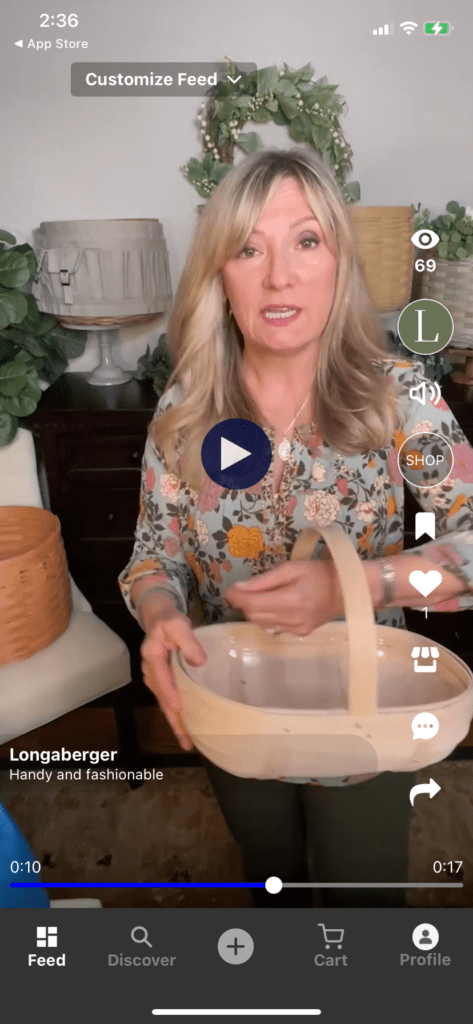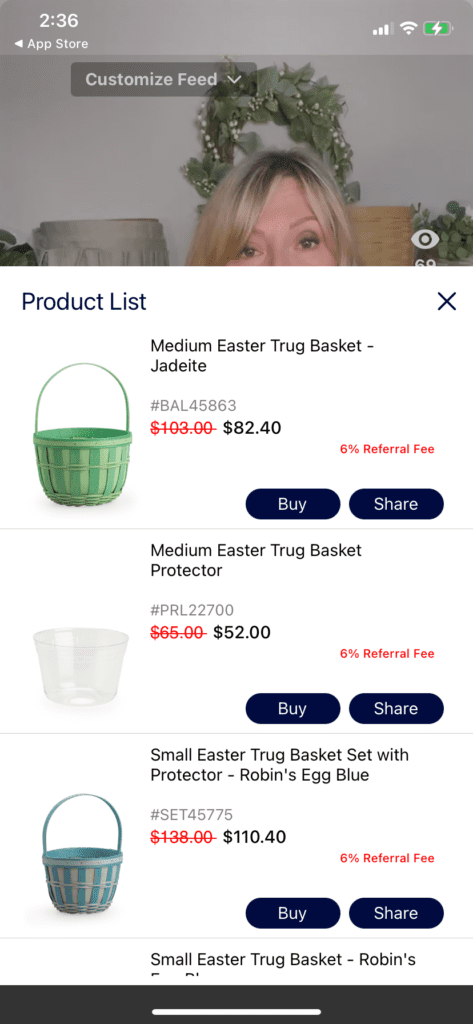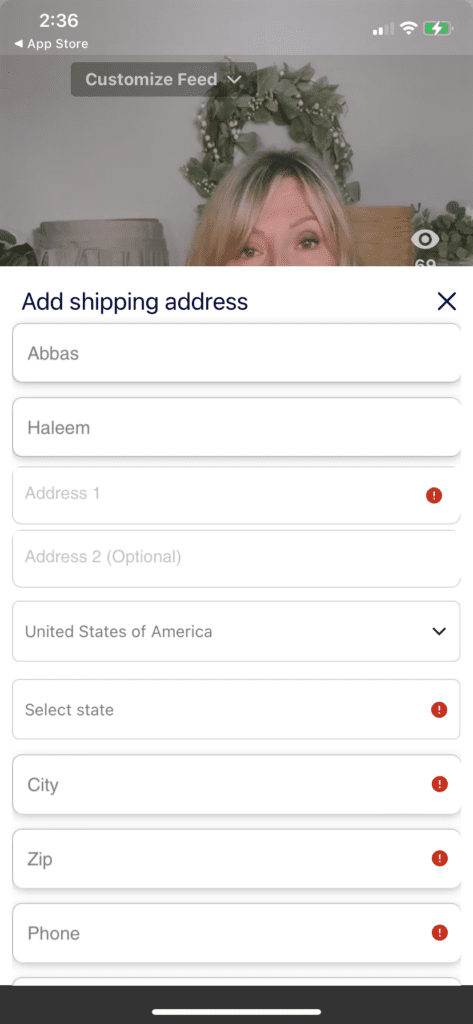Influencer marketing in its current state does not produce a strong enough return on investment, says Faisal Ahmed, co-founder and CEO of the newly launched Orme online marketplace.
“It’s an endless pit,” said Ahmed, who is also the CEO of textile company Artistic Denim Mills and founder of denim brand DL1961.
Orme shows users a feed of videos based on their interests, much like on TikTok and Instagram Reels. What’s different, though, is that each video displays at least one product users can buy, and they can do so before scrolling to another video.
Whereas influencers often get paid one-time fees, “there’s no ROI for us,” Ahmed said. “All the digital managers [were telling us,] ‘You have to invest!’ And we said enough is enough. We have to create a system which is an ecosystem for influencers, brands and the shoppers so that the CMOs and the owners can see where the money is going.”
He told Digital Commerce 360 that’s what led him to start Orme with co-founder Robert D’Loren. The social commerce marketplace went live in April 2024. D’Loren, who is also chairman and CEO of Xcel Brands Inc., described the marketplace as the intersection of shopping, entertainment and social media.
D’Loren said Orme intends to compete with TikTok Shop, for example, by taking a different approach to how users make money on the two marketplaces.
“Their models are based on ad dollars. … We’re not out to sell ad dollars,” D’Loren said. “We’re out to get 100 million people sharing and earning. It democratizes all of this.”
‘Flip the model’ by which influencers get paid
D’Loren cited data from consulting firm McKinsey & Co. saying that worldwide conversion rates from influencers are “at best 3%,” and conversion rates in affiliate marketing are less than 1%.
“Therein lies the problem,” D’Loren told Digital Commerce 360. “When you have such low conversion rates, and since the change in the privacy rules where you really can’t follow your customer around the internet anymore, digital marketing doesn’t quite work either. So customer acquisition cost has become prohibitively expensive. And there’s no solution for it. The only right solution would be to flip the model. Transition it from a pay-to-play model to a pay-for-performance model.”
As opposed to one-time fees, influencers who facilitate product sales on Orme can receive different percentages of those sales. If a user or influencer makes a video and shares it, then someone purchases directly from that video, the user receives 6% of the sale.
“Someone can pick up [that] content and share it on Instagram or any social network or platform,” D’Loren said. That user gets paid 2%. The person who shared it gets 6%. “That’s how this whole thing works.”
In other words, if 50 people share a creator’s video, and those 50 people each make at least one sale, the creator makes 2% of each product sold through her content, plus 6% on any sales made directly from her own video. The 50 users who shared the video then get 6% of each purchase made from their shared video.
Orme has launched with seven merchants and more than 1,000 users who downloaded the app in its first week without using any email campaigns, D’Loren said in a recent Xcel Brands earnings call with investors. Xcel Brands announced $2.3 million in net revenue for its fiscal fourth quarter ended Dec. 31, 2023. That’s a 44% decrease from its Q4 2022, down $1.8 million.
Xcel launched Orme as “a joint venture with a technology company in which Xcel owns a 30% interest in this new video and social commerce marketplace,” D’Loren told investors on the call.
How does Orme work?
Similar to TikTok and Instagram Reels, Orme users can swipe up within the app to view videos. Also, as on TikTok, there is a vertical list of buttons on the right side that allows users to click on a brand or user’s profile page. That page shows other videos the users or brands have made, as well as items they sell, saved recordings of shows they’ve produced, any live shows they’re hosting, and any upcoming events they have planned.

An Orme video from Longaberger, which manufactures and distributes houseware items, displays one of the brand’s wooden baskets.
The video above displays a basket from retail brand Longaberger. Xcel owns Longaberger, as well as other brands including Halston, Judith Ripka and more. Among the other options in the buttons on a video are a button to save a video, “like” it, add its products to one’s own store on Orme, and a “shop” button. A distinguishing factor between Orme and TikTok (and its in-app TikTok Shop) is that the video portion and ecommerce shop portion are not separated.

Clicking the “shop” button on the Longaberger video shows what products a user can purchase directly from that video page.
Users can then check out directly from the video page without being taken to a different part of the app or being redirected to an ecommerce website.

The checkout page on Orme slides up to temporarily cover the video a user is watching. Once a user completes her purchase, she can continue to scroll where she left off.
What happens to an order after checkout?
When a consumer completes a purchase on Orme, the app’s APIs (application programming interfaces) connect directly with the merchant, inserting the order into their system and triggering the merchant’s customer relationship management (CRM) system. In this case, that means an order placed on Orme for a Longaberger basket will appear in Longaberger’s ecommerce system. Longaberger is then responsible for sales tax, fulfillment and post-purchase communication.
“For all practical purposes, it’s their customer,” Ahmed said.
He added that these merchants don’t want to part with their customers.
And everything has to happen in real time, Ahmed said. That means Orme needs API connectivity to automatically update product information and changes to pricing, inventory, descriptions and imagery.
“And we did that without navigating the customer away from the video,” D’Loren said. “Most platforms take the customer away and they put them on the ecom site. That doesn’t happen on Orme. But the whole back end and the customer journey stays exactly the way it is with the vendor today. We didn’t want to disrupt that customer journey experience in any way, shape or form.”
How do users get paid on Orme?
Marketplaces sometimes hold a merchant’s money for up to 60 days, Ahmed said. TikTok says it initiates payout to sellers one to eight days after an order delivery date. It adds that “the exact number of days is determined based on your shipping performance.”
Orme pays its merchants their share of a sale immediately, splitting the payment at checkout, Ahmed said. Merchants like Longaberger get 75% of the total sale price, and 25% goes to Orme. From that 25%, the marketplace pays:
- Influencers it credits with getting the consumer to convert (the above-mentioned 2% and 6% referral rates).
- Credit card processing fees (Orme currently uses Stripe for this).
- The shoppers, who can choose to keep their referral earnings in their Orme account and use them like a cash-back system.
“That’s 10% they would have spent anyway,” D’Loren said. “So what are they really paying? 15%.”
TikTok announced it will take increase its fees to 8% this year on most items, from 2% plus $0.30 per sale, The Information first reported.
Do you rank in our databases?
Submit your data and we’ll see where you fit in our next ranking update.
Sign up
Stay on top of the latest developments in the ecommerce industry. Sign up for a complimentary subscription to Digital Commerce 360 Retail News. Follow us on LinkedIn, Twitter, Facebook and YouTube. Be the first to know when Digital Commerce 360 publishes news content.
Favorite